Moderate physical activity will ensure not only the comfortable state of the woman during the period of bearing the baby, but also prepare her body for subsequent childbirth.
With the advent of a new life in the body of a new life, pregnant women believe that now they should be treated especially carefully to their body. This is partly true. Indeed, on the shoulders of the future mother lies responsibility not only for herself, but also for another little man. However, there is also no one should also completely abandon physical activity, especially if there are no contraindications from health for this. Moreover, a feasible load will help to support the body in good physical shape and successfully pass not only 9 months of waiting for the crumbs, but also of subsequent births. Yoga classes during pregnancy are a good way to prepare for the birth of a baby both physically and psychologically.
Pregnancy and yoga
The period of “interesting situation” is the time of active changes in the female body. All organs and systems work in an intensified mode, hormonal restructuring also affect the emotional state of a woman. That is why it is very important for the expectant mother to learn to understand and accept his body and everything that happens to him during the gaping of the peanut. Many women are worried about the question, is it possible to deal with yoga during pregnancy? Will these exercises be dangerous and will the execution of asanas lead to a breakdown of pregnancy? A competent approach to training, a consultation of not only a doctor of an obstetrician-gynecologist, but also a specialized coach will help to avoid all possible risks associated with physical exertion.
The benefits of yoga during pregnancy
Yoga is not only a popular, but also very useful practice. In addition, to perform the technician there is no need to visit the gym. A woman can do all the exercises at home at a convenient time and in a comfortable atmosphere. Besides:
- Yoga is not only a set of stretching exercises, but also the methods of relaxation, proper breathing, cleansing the body as a whole and strengthening the spirit.
- Yoga classes make the body of the future mother more plastic. Thanks to this, during childbirth, it is easier for a woman to take a position convenient for her, the risk of crotch ruptures decreases.
- Strengthening the joints and spine, which occurs during the exercise, helps more easily cope with the increased load that they experience during the bearing of the child.
- Blood circulation in the pelvis is improved.
- Techniques help to cope with toxicosis.
- Performing breathing exercises contributes to the full saturation of the body with oxygen, which is important not only for a woman, but also a baby (serves good prevention of hypoxia). In addition, the ability to breathe correctly is a sought -after skill during childbirth.
- Psychological preparation reduces the likelihood of postpartum depression.
- For the baby, the performance of the yoga technician is also useful, especially inverted poses (exception - stand on the head), which contribute to the correct placement of the fetus.
- It is mistaken to believe that the main goal of yoga is to learn to “put” your body in bizarre poses and do without food. The technique teaches us convenience in any unusual and that possibly not a comfortable situation.
- The implementation of the technique helps to get rid of pain that often occurs in women during the period of gestation (especially in the lumbar region), reduce the pain directly during childbirth.
- Improving the physical and emotional state has a beneficial effect on all systems of the female body, strengthens immunity.
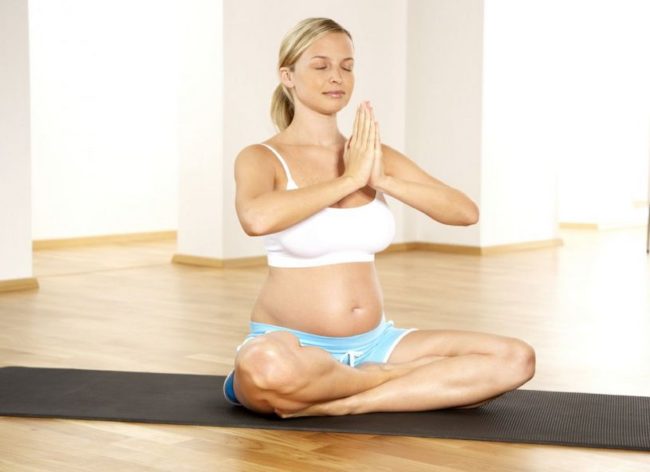
Yoga during pregnancy: recommendations and precautions
- All asanas are performed exclusively smoothly, without jerks and sharp (aerobic) movements.
- If before an interesting position, you were not familiar with yoga, start with a low load, gradually preparing your body for each new stage. Classes are recommended to start with the second trimester, when one of the most important "crisis" stages is 8-12 weeks-behind.
- During the execution of asanas, you should not experience pain or discomfort. Any negative change in the condition is a signal to stop the exercise. The same applies to the appearance of nausea or dizziness during the implementation of the technique.
- To perform breathing exercises, it is better to take the position of sitting or reclining.
- Before starting training, even if you feel good and the pregnancy proceeds without threats, you will receive a doctor’s advice on the safety of the exercises you have chosen.
- In 2 and 3 trimesters, pay attention to the poses standing by the support. The performance of these methods will reduce the risk of edema, seizures, improve the blood supply to the child, strengthen the spine and help control weight.
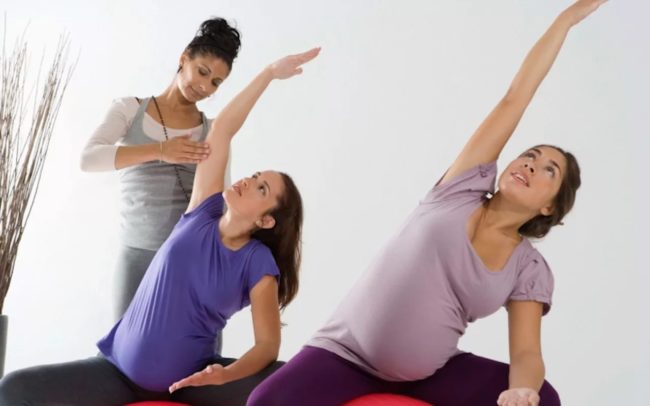
Yoga during pregnancy: forbidden asanas
The complex for expectant mothers excludes the exercises in which there are:
- Twisting is the maximum approximation of the limbs to the body. These techniques create voltage (squeezing) in the abdomen, which expectant mothers are useless.
- Degbs back from the position of lying down. At the same time, the body weight is tolerated and retained again in the abdomen, which is categorically unacceptable for pregnant women.
- During the implementation of yoga techniques during pregnancy, the balance exercises (balances), in which there are no usual points of the support, should also be avoided.
- The expectant mothers are contraindicated in the performance of exercises for which it is necessary to lie on the stomach or on the back and strain the abdominal muscles. The alternative will be the implementation of such techniques on the side.
- Inverted asanas are carried out with caution and under the control of a specialist. The stand on the head is categorically not recommended.
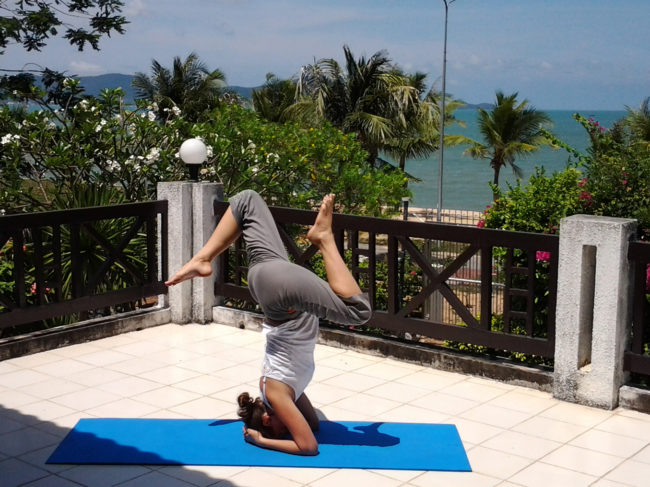
Contraindications for yoga during pregnancy
However, yoga is allowed not to engage in all future mothers. The list of contraindications to the exercises include:
- Increased blood pressure (hypertension).
- Hypertonus. Yoga classes with increased uterine tone are strictly prohibited during pregnancy.
- The threat of a breakdown of pregnancy.
- Disorders in the work of the cardiovascular system.
- Problems of the musculoskeletal system.
- Late toxicosis (gestosis).
- The low location of the placenta (presentation) is not an absolute contraindication to the execution of asanas, but requires additional consultation of a doctor.

Yoga during pregnancy
Thanks to the increase in the level of the hormone of the relaxin, which is responsible for the relaxation of the ligaments of the pelvis and the disclosure of the latter, the exercises for stretching are given to expectant mothers quite easily. However, it is important not to overdo it and not develop.
Yoga in the first trimester of pregnancy
In the first weeks of waiting for the little, complete relaxation and rest is especially important. The development of deep breathing techniques will be relevant.
- The position "table". The exercise will help strengthen muscles and will be an excellent balance of balance. The starting position is standing on all fours. On inspiration, smoothly raise your right leg parallel to the floor. The neck and spine form a single line. Exhaled. On the next inhalation, raise your left hand. And exhale again. Stay in this position of the next 3-6 respiratory movements. You should be comfortable. Next, return to the original pose and repeat similar actions for the left leg. The number of repetitions is 3 times for each side. If there are problems with the wrists, try to squeeze your fists and transfer the weight to them.

- The position of the "puppy". This technique of yoga during pregnancy in the early stages effectively fights annoying nausea. In addition, the pose helps to relax and get rid of negative thoughts. The basic position is standing on all fours. The hands are straightened, the shoulders are located strictly above the wrists. Next, on a deep exhalation, take the buttocks back (the priest barely touches the heels). At the same time, the hands stretched forward. The elbows do not touch the floor. Lower your head (forehead) to the floor or pillow (the buttocks rose). Reach. With each exit, you should feel how your back from the neck to the sacrum lengthen. Keep this position for 30-60 seconds, but without overstrain. To get out of position, lower the buttocks on the heels. In the presence of discomfort in the area of \u200b\u200bthe head or nasal sinuses, try to fold the brushes under the chin. If you feel excessive tension in your shoulders, bend your hands and emphasize your elbows.
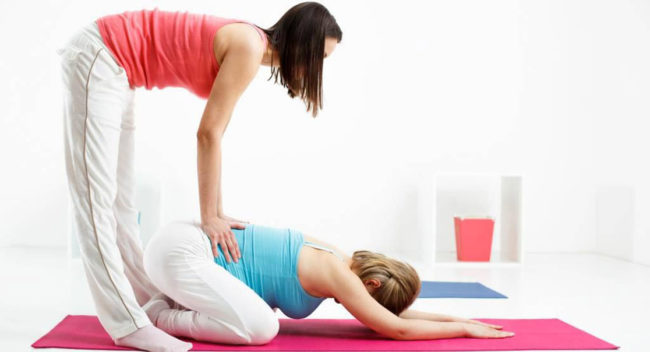
- The position of "Happy Child" provides high -quality stretching of the muscles of the thighs, relieves tension in the abdomen. In the lying position, bend your knees and spread them to the sides. Grasp the feet with your hands. The knees are gently pulled to the armpits, while the heels strive for the ceiling. Feel how not only the femoral muscles, but also the spine are stretched. Hold this position for a minute or more. To go out smoothly, lower your legs to the floor.
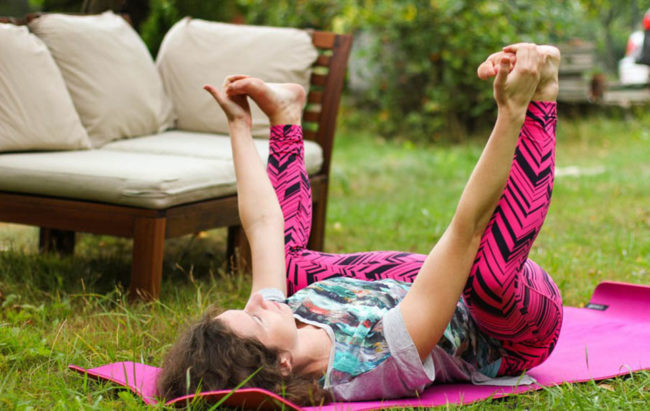
- The position of the “bolt” stimulates the stretching of the lateral muscles, gently relieved the tension in the uterine area. Take your knees. Take the right leg aside. Raise your left hand up, bend it slightly at the elbow. Put the hand of the same name on the right foot and begin to slip it smoothly along the leg. A deep breath is replaced by a smooth exhalation, on which you try to lower your right hand as low as possible. At each exit, try to linger 30-60 seconds. After repeat similar actions for the left leg.

- The position of “capture of the foot” will help stretch the inner thighs and open the hip joints. Lie down on your back and raise your right right leg. In this case, the left limb is bent at the knee. The knee is assigned to the side. Grace up the foot with your right hand and fix this position on a few breaths. If you fail to reach your feet, use a strap or scarf. The left knee should not lag behind the floor surface, help hold it with your left hand.
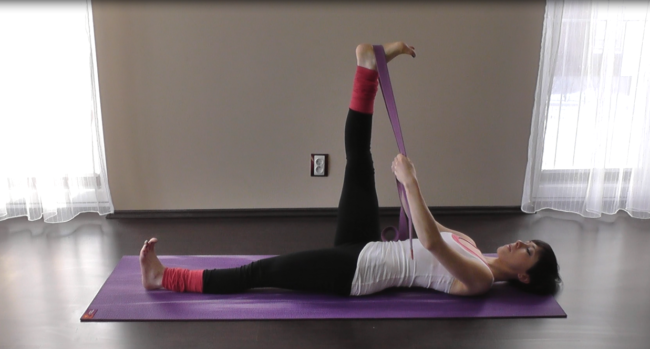
- The position of the "King of the Dancing" in the position of lying down. The technique reveals the chest, as a result, the lungs expand, the flow of oxygen increases, the blood flow improves. The disclosure of the diaphragm leads to an increase in space in the stomach. As a result - a decrease in nausea, heartburn. The pose stimulates stretching the muscles of the thigh. The starting position is lying on the left side. Put your left hand under your head. Bend your knees a little and take them back. Grab the right ankle with your right hand and gently pull the foot to the buttocks, increasing the attraction on the exhale. Lye in this position on 3-4 respiratory traffic and proceed in the exercise on another side.
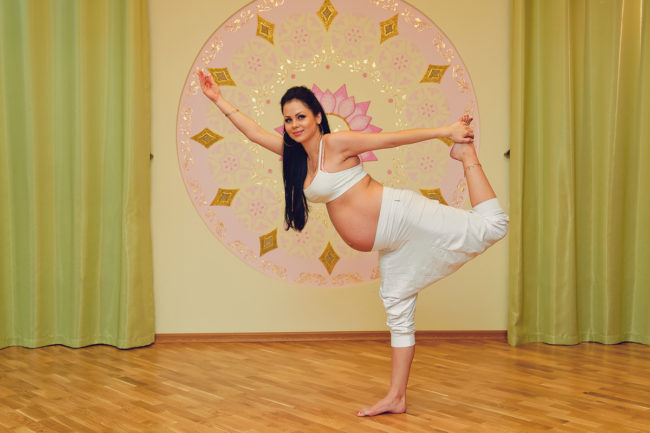
Among the safe at this stage, the technician should also note the following asanas: Triconasana, Vrickshasana, Shavasana.
- Shavasana. Lie down on your back. Under your head, place a small pillow or any other support. Damage your hands to the sides. Relax your legs, allowing the feet to "fall apart" to the sides. Perform 20 respiratory cycles of maximum relaxation.
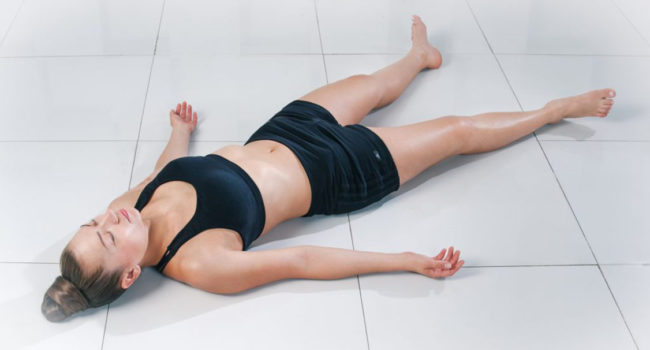
- Vickshasana. Standing completely on the feet, stretch your hands up. The breath is even. In another interpretation of this asana, you can bend your right leg in the knee and pull the foot as close as possible to the crotch. The knee is assigned to the side.

- Triconasana. The legs are located about a meter from each other. The right foot "looks" aside, the left is straight. Perform a tilt towards the right leg, while the right hand falls on the foot, and the left hand rushes vertically upwards.
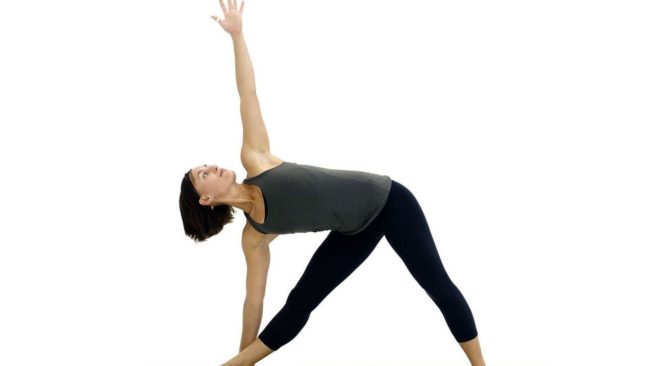
Yoga in the second trimester of pregnancy
The second trimester (from 15-16 to 32-34 weeks) is the most active period in the life of the future mother. The stomach has not yet increased too much, so it does not create "technical" problems, while the body is already used to its new state and learned to work as comfortable as possible for its mistress. That is why physical activity is especially useful at this stage of pregnancy. The most acceptable yoga postures during pregnancy of the second trimester are Baddha Konasan, Supta Baddha Konasan, Padavishtha Konasan, Viparita Karani Mudra. Each of the positions must be held 30-60 seconds. If such a time period is given with difficulty, start from less.
- Baddha Konasana. Sit on the floor, fold your legs in the “butterfly” pose so that the knees form a sharp corner. Softly bring your knees to the floor.
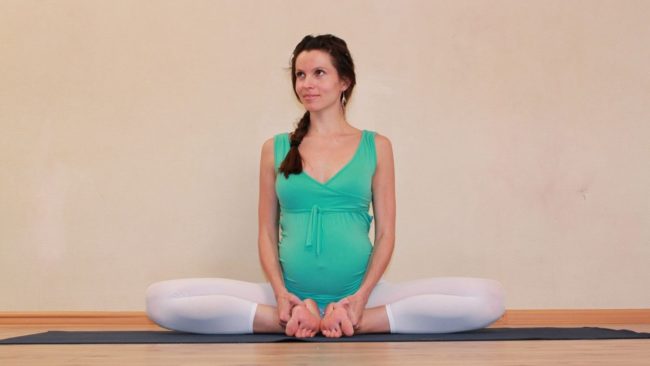
- Supta Baddha Konasana. Lie down on your back. The legs are folded with a “butterfly”, the feet are closed with each other and tightened to the crotch. As much as possible, dilute your knees and hips to the sides.
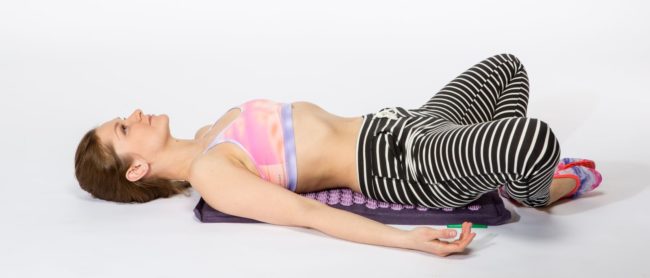
- Padavishtha Konasana. Sit on the floor. Dilute straight legs as wider as possible. Hands are located on both side of the pelvis. Having pushed them away from the floor, straighten the body and direct the chest forward how much your flexibility allows (the slope begin with the movement of the hip joint, then the chest and only at the very end - the head). Lying in this position for 2-3 minutes, continuing to breathe smoothly and calmly. Try to relax at the same time, you can close your eyes.
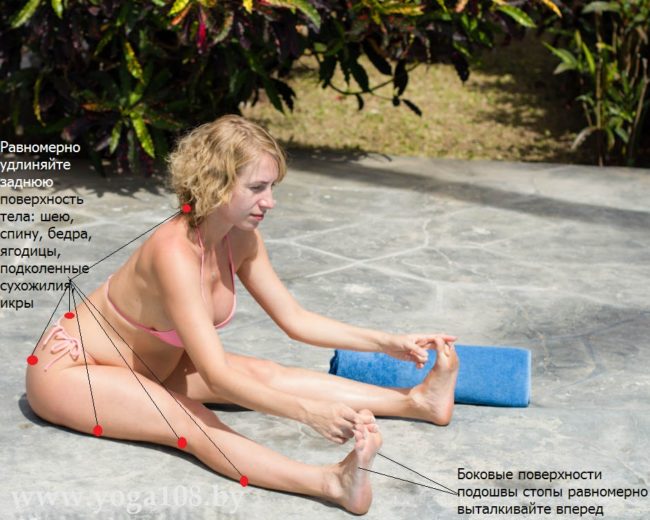
- Viparita Karani Mudra. Lie down on your back. Next, raise your legs vertically up and put them on the wall, using the latter as a support. Now you should raise the pelvis a little. To do this, explain under the area, put a pillow or a roller from a towel. If the second stage cannot be done, stop at the first (lift your legs).
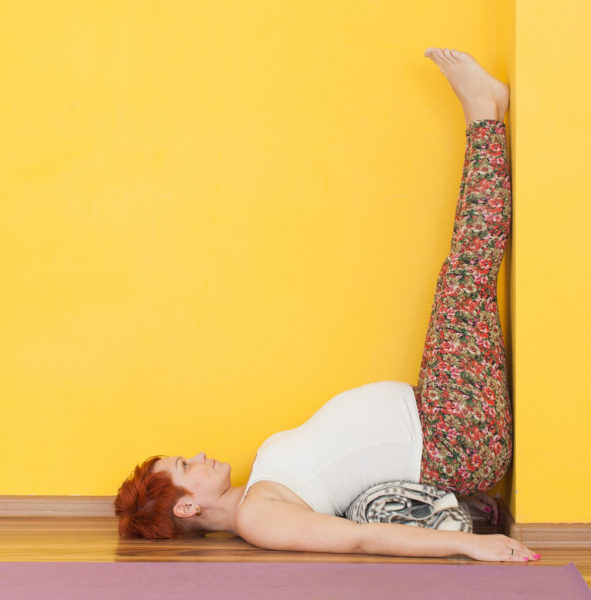
Yoga in the third trimester of pregnancy
The closer the meeting with the baby, the more smooth and measured the movements of the future mother become. This is not surprising, because the peanut and the tummy in which he lives has already grown significantly. Therefore, from 32-34 weeks, the first difficulties often begin with the implementation of some asanas. To support the body, women begin to use more pillows, blankets. At this stage, the main attention is again paid to breathing techniques - the features of birth breathing, relaxation methods are studied. Do not forget that after the 35th week to maintain the normal activity of the placenta, you need to drink a sufficient amount of water. The optimal asanas of the Third Trixer are Baddha Konasan, Padavishtha Konasan, Triconasan, Utkhita Parsvakonasana, Gorka.
What to do if, on all calculations, the period of the appearance of the peanut has already occurred, and the baby is in no hurry to be born? In this case, medical workers recommend stimulation of childbirth. And we all know that artificial intervention in the natural process is not very good. Therefore, a woman may try to cause childbirth, but more natural methods - conversations with the baby, breathing on the technique of udzhai, performing micro -motion pelvis. The sound of the sound “U”, tea from raspberry leaves, as well as massage actions in the perineum, also have a beneficial effect.

Love yourself and your body, because pregnancy and yoga, as the video below, can perfectly harmonize with each other.


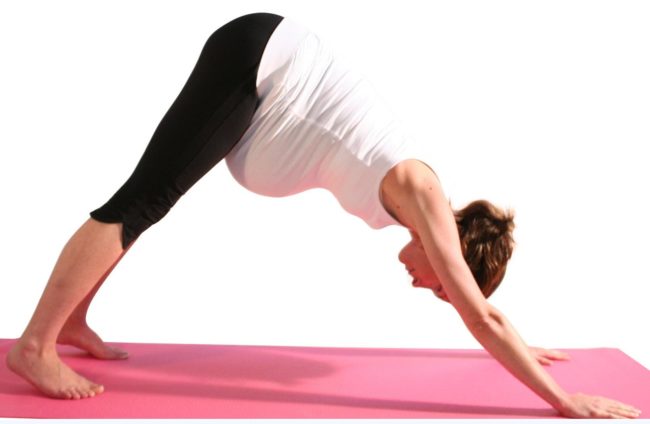







Comments
a couple of years ago, there was no side of metrogils from the same problem, there were no side effects ...
I’m not a fan of peeling at all, it saves from acne of metrogil, it also smoothes it ...
Great article! ...
I take the second course of the Capsules Climafite 911. The tides went very quickly. It became calmer, irritability went away and I sleep well ...
i also noticed - it is worth nervous, everything immediately affects the face. Therefore, I try to avoid conflicts and unpleasant people. Of the creams, I like Miaflow from wrinkles - smoothes not only small wrinkles ...